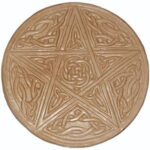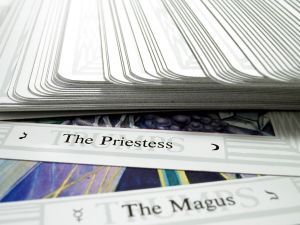The biggest part of Tarot is the Minor Arcana. Four suits of cards – wands, swords, pentacles, and cups – each have 14 members numbered 1-10 and including at the end Page, Knight, Queen, and King of the suit. It is easy to see how the modern deck of playing cards was derived from this part of the Tarot.
If you’re trying to learn Tarot, this section of the deck can be daunting; they all look alike and there are so many! But like the Major Arcana, the Minor Arcana follows a very distinct pattern; in fact, its pattern is much easier to discern.
This description of reading the Minor Arcana is based on the Rider-Waite version; however, most other decks follow approximately the same pattern. If you prefer the Deck of the Cats or the Witches’ Deck or most of the other popular decks, most of the following information will work for them as well, with appropriate substitution of words.
Understanding the Suits
Lay out your cards in four rows by suit and in order before you start studying them. You will see some very clear patterns both across and up and down; but the first thing you must do is know what each of the suits means.
Wands is the suit of energy and communications. If the Internet is controlled by one of the Tarot suits, it’s wands. Each card in this suit refers directly or indirectly to issues based on energy or the lack thereof. Most of them also deal with communications – messages, conversations, arguments. The element associated with wands is fire; a person associated with wands is likely to be fair-skinned, blue-eyed, and blonde, and/or to have an astrological sign associated with fire.
Swords are the suit of strife and struggle. A reading heavy with swords indicates the querent – the one asking a question – has a lot going on in his or her life. Swords are associated with the element air; in some decks, they are actually feathers. A person associated with swords will likely be somewhat fair skinned, with hair of medium darkness (often red), and will be of a quarrelsome or stubborn nature.
Cups are the suit of love and emotions, and also of religion. You can equate cups with the Holy Grail in many ways; the Arthurian legends are filled with cup symbolism, and the suit of cups is also filled with Arthurian symbolism. A person associate with cups is probably dark haired and hazel eyed, and of a romantic disposition. Cups are associated astrologically with water.
The last suit is pentacles, while cups symbolize love both heavenly and romantic, pentacles symbolize fertility and earthly wealth. Pentacles can be associated with the cauldrons of Irish myth. Pentacles often indicate children or success. A person represented by pentacles is generally dark of complexion, hair, and eye, with a contemplative disposition. Pentacles are associated with earth.
Understanding the Numbers
Once you understand the suits, you can start looking down columns. You’ll note that there are some common themes; for instance, in the 1 of each suit, the suit symbol is represented huge and without human figures. That is because the 1 is the most pure meaning for each, and typically means the inception of that suit’s meaning. So a one of pentacles often means a new baby or a new job; one of cups means a new love.
The two typically refers to some sort of duality. Think yin-yang, light and dark, pepper and salt. It may be a partnership, or it may be a choice the querent needs to make in the near future. If the card is right side up, the choice or duality is balanced (or, sometimes, in stasis or stagnant); inverted, the duality is out of balance, making choices easier but relationships difficult.
The three is a completed cycle. Just as you can sit comfortably on a three-legged stool, or as the child completes the family that started with two, a three in Tarot indicates initial achievement. See it as a platform or stair landing, from which your querent can build further; though it is by no means complete, your querent is on his or her way to success. Inverted, it means backwards movement or imbalance, sometimes even failure.
Fours indicate a solid foundation, like the three only more stable yet. But where the three indicates a high level of creativity, the four may sometimes indicate a stagnation. For instance, the three of cups is a creative celebration of achievement; the four of cups is a looking backward, dwelling on the past rather than dipping into the creative pool that exists inside all of us. For this reason, an inverted four can often be a good thing, not a negative one. Many upright fours in a reading that includes a beginning, however, indicate that the querent is starting with a very good foundation.
Fives are instability and conflict. Visualize the fifth wheel. However, a five indicates that the querent has an excellent opportunity for change or to initiate a new cycle beginning. For a writer, for instance, fives show up when it’s time to start a new book or project. Inverted, fives almost always indicate serious negative conflict that needs to be dealt with.
The six has to do with communication and cooperation. It is another stage, like the three, but is more balanced. Several sixes may indicate that it’s time for the querent to take a break; a six of hearts or pentacles indicates a good time for a second honeymoon.
Sevens have to do with spirituality and deep wisdom. The querent should reflect on his or her life. What have their motives and motivations been recently? Are they doing things for the right reasons? When sevens are up, the querent is ripe for that personal one-day retreat to think about everything.
Eight has more to do with motion and power. Look at the eight in the Major Arcana – Strength. This holds true for the suited eights as well. Eight may indicate rebirth or regeneration, a time to re-evaluate one’s current life situation and goals, and the opportunity for serious changes.
Nines have to do with winding things down. You can start seeing things working – or not working – as a full cycle draws to a close. If you are seeing nines, you should also be seeing the light at the end of a tunnel. If not, perhaps you should start looking for it.
Tens are the full fruition or completion of a cycle. The ten of cups, for instance, is often called the wish card, for it indicates that the querent has achieved all he or she has desired in life. When tens are seen in a spread, whether positive or negative, it indicates that a cycle has been completed and a new one is ripe to begin.
Understanding the Face Cards
I’ve always had more trouble with face cards than anything, perhaps because face cards often indicate real people and I’m a bit of a hermit. But they are much more than just indications of people. For instance, they may indicate the querent in the past, present, or future, or an aspect of that person emotionally. They may also indicate a person in the querent’s current sphere of influence who can move the querent right now, or who the querent needs to look at.
When face cards come up, look at everything else first. It’s difficult to interpret face cards without understanding the context within which they appear. Once you’ve gotten an idea of what’s going on in the reading as a whole, focus on the face cards. What clues can you glean from the position in the spread? Does it seem to refer to a person or an event?
This is where your reading becomes art, not craft. Trust your intuition. Some teachers of the Tarot suggest that you “open” yourself to the meaning behind the card. What is the emotion behind the spread? Are there physical characteristics related to the querent, as described in the suits section above?(By the way, kings and queens are typically married or divorced individuals, while knights and pages are young men and women who have never been married.)
Examining the face cards, while difficult, can result in a better understanding of your querent overall and thus a better understanding of the entire reading. Think about physical characteristics, personality traits, relationships between the person represented by the face card and the querent, possible spiritual influences working in the querent’s life, or even (especially with pages and knights) events or situations that may be at work.
Conclusion
This short guide should be no means be considered the end-all to the Minor Arcana. While the Major Arcana can be very powerful influences on the querent, the minor cards indicate those subtle influences that make a reading very personal.
Memorize these meanings, and you’ll have an easy handle on an overall reading. Pick up a good book on Tarot as well that treats each of the Minor Arcana individually, however, and you’ll be able to understand the subtle differences between the cards. Use this tutorial and my Major Arcana tutorial as your introduction to further studies, not as a graduate course, and you’ll be well on your way to a true understanding of the Tarot.
Reference:
- Read more of this series at www.associatedcontent.com/article/55577/learning_tarot_guide_to_the_major_arcana.html





